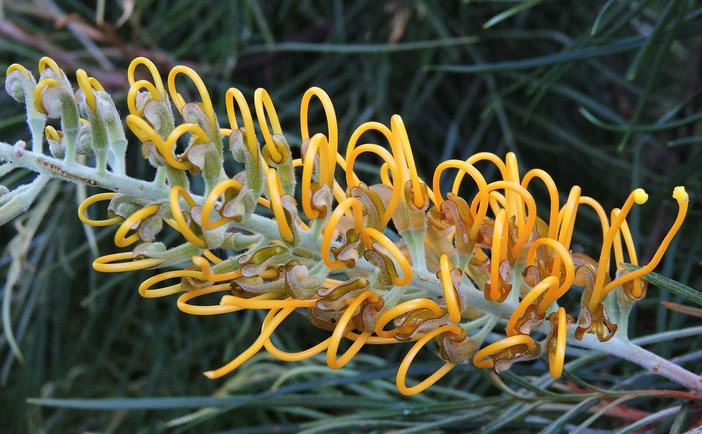Needle Bush
(Hakea adnata)
Needle Bush (Hakea adnata)
/
/

Derek Keats
CC BY 2.0
Image By:
Derek Keats
Recorded By:
Copyright:
CC BY 2.0
Copyright Notice:
Photo by: Derek Keats | License Type: CC BY 2.0 | License URL: https://creativecommons.org/licenses/by/2.0/ | Uploader: Derek Keats | Publisher: Flickr






Estimated Native Range
Summary
Hakea adnata, commonly known as Needle Bush, is an evergreen shrub endemic to the sandy plains and sclerophyll forests of Southwestern Australia. It is a non-lignotuberous, upright, broom-like shrub with a multi-stemmed habit, typically growing to a height of 1 to 3.5 meters (3 to 11 ft). Needle Bush is notable for its masses of sweetly scented white flowers, each inflorescence bearing 2-6 blooms in the leaf axils. The flowers, which appear from late winter to spring, have pedicels 2–2.5 mm (0.08–0.1 in) long covered with flat dense silky white hairs that extend onto the lower parts of the flower. The shrub’s appearance is enhanced by its needle-like foliage, which adds texture to garden settings.
Needle Bush is valued for its fragrant white flowers and its adaptability to a range of garden conditions. It is often used in xeriscaping due to its low water requirements and is suitable for full sun to part shade locations. It thrives in well-drained soils, preferring sandy substrates. While it is relatively low-maintenance, it may benefit from occasional pruning to maintain its shape and encourage denser growth. In cultivation, it is used for ornamental purposes, particularly in native plant gardens and as a feature shrub in mixed borders. Gardeners should be aware that Hakea species can be susceptible to root rot if overwatered or planted in poorly drained soils.CC BY-SA 4.0
Needle Bush is valued for its fragrant white flowers and its adaptability to a range of garden conditions. It is often used in xeriscaping due to its low water requirements and is suitable for full sun to part shade locations. It thrives in well-drained soils, preferring sandy substrates. While it is relatively low-maintenance, it may benefit from occasional pruning to maintain its shape and encourage denser growth. In cultivation, it is used for ornamental purposes, particularly in native plant gardens and as a feature shrub in mixed borders. Gardeners should be aware that Hakea species can be susceptible to root rot if overwatered or planted in poorly drained soils.CC BY-SA 4.0
Plant Description
- Plant Type: Shrub
- Height: 3-11 feet
- Width: 3-7 feet
- Growth Rate: Moderate
- Flower Color: White
- Flowering Season: Winter, Spring
- Leaf Retention: Evergreen
Growth Requirements
- Sun: Full Sun, Part Shade
- Water: Low
- Drainage: Fast, Medium
Common Uses
Bird Garden, Butterfly Garden, Low Maintenance
Natural Habitat
Endemic to the sandy plains and sclerophyll forests of Southwestern Australia
Other Names
Common Names:
Scientific Names: , Hakea adnata, Hakea lativalvis,
GBIF Accepted Name: Hakea adnata R.Br.